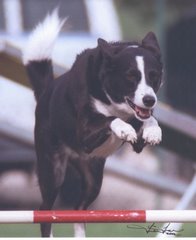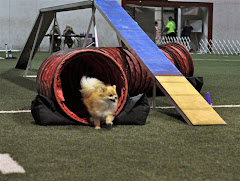Also known as hypoadrenocorticism, Addison's is a disease characterized by a decrease in certain substances produced by the adrenal glands.
That makes the adrenal glands a good place to start. The adrenal glands are very small glands associated with each kidney. Normally you don't even notice them during abdominal surgery. There are two parts to the adrenal gland, the medulla and the cortex. The medulla is responsible for producing catecholamines like epinephrine. The cortex is further divided into three zones, the glomerulosa, fasciculata, and reticularis. The glomerulosa produces mineralcorticoids or aldosterone. Mineralcorticoids control electrolytes and water balance. The fasciculata produces glucocorticoids or cortisol. Cortisol affects glucose, protein and fat metabolism.
Now, about the actual disease. There are two types of Addison's-primary and secondary. By far, primary is the most common form and is an idiopathic, immune-mediated destruction of the glomerulosa and fasciculata resulting in decreased production of mineralcorticoids and glucocorticoids. The mineralcorticoid deficiency results in hypovolemia (dehydration and shock), decreased blood flow to the kidneys and decreased cardiac output (lowered circulatory ability). The glucocorticoid deficiency results in GI signs such as anorexia and vomiting as well as lethargy. Because glucocorticoids also help the body deal with stress, clinical signs may only show during stressful times in the pet's life in the early course of the disease. Typical presentations include changes in mentation, lethargy, weight loss, weakness, anorexia, vomiting, dehydration, slow heart rate, increased thirst and urination and sometimes an episodic or waxing and waning course of disease. Common labwork abnormalities include electrolyte imbalances ( increased potassium and decreased sodium), elevated kidney values, and mild anemia. Unfortunately any combination of these symptoms and abnormalities can also be suggestive of other, more common disease such related to the GI system, urinary tract or even liver. The fact that Addison's can imitate so many other diseases coupled with it's rarity can make it a diagnostic challenge and a disease that can sometimes be overlooked. This is particularly problematic because the dog will often respond will and stabilize with symptomatic therapy but crash again later-recurrent events should be a red flag! Additional diagnostics include an ECG to check for abnormalities related to increased Potassium and imaging such as radiographs and ultrasound. These may be suggestive of, but not diagnostic for Addison's.
To make a definitive diagnosis an ACTH stim test is performed. ACTH is a hormone produced by the pituitary gland in the brain that stimulates the adrenal gland to produce more cortisol. To perform the test you administer synthetic ACTH to force the adrenal gland to ramp up production. But since that part of the gland is not functioning in Addisonian dogs, there is no response and cortisol levels remain low.
Immediate treatment for Addison's disease (assuming the dog has presented in crisis) is IV fluid therapy with appropriately balanced electrolytes and replacement of glucocorticoids. Once stable there are two choices in treatments. The first one is Florinef tablets (fludrocortisone acetate). Some dogs do not respond well to this treatment and some develop undesired side effects at levels that adequately control the disease. The better option is injections of Percorten (desoxycorticosterone pivalate or DOCP) which replaces the mineralcorticoids. These injections are usually given in 25-28 day intervals and the owner can be shown how to give them at home if desired. Prednisone is given in small doses to replace the glucocorticoid deficiency. Sometimes, the amount of prednisone needs to be increased during stressful situations.
Follow up therapy involves checking electrolytes in specified intervals after the Percorten injections. This will be more frequent at first until the desired dose for the individual dog is reached. There are a variety of maintenance and monitoring protocols I have found and I won't even begin to speculate on which one is the "best" as I have never even diagnosed a case of Addison's!
Addison's is most common in middle age female dogs with no significant breed predilections. The prognosis for Addison's, once diagnosed and stable, is excellent although lifelong treatment is required. Addison's is rare in cats. Tomorrow we will have a special guest post from Karissa of Secret's Journey. She will share her experiences as an owner of an Addisonian agility dog.
The Next Chapter
19 hours ago


.jpg)
.jpg)



.jpg)



8 comments:
Since you posted on Addisons, could you post on it's (somewhat) opposite, Cushings Disease?
Love the blog, thanks for the great info!
Great & informative post!
Regarding the last statement about breed -- Perhaps it was more or less just information gleaned from the Addison Dog list on Yahoo, but it seems to occur most frequently in Standard Poodles and Labrador Retrievers, although any dog may become Addisonian.
I agree with the above comment about Cushings -- I would love to hear more about the flip side. I have an agility friend with a Cushings dog and I've heard what they go through. To be honest, I think I prefer Addisons. My friend has always said, "They don't die from Cushings, they die from the treatment." It would be great if you could expand on this.
I did see one reference about poodles and labs but did not see it repeated anywhere so I left it out-but sounds like there might be something to it!
If you look at my post titled Endocrine Disease you will find an overview of Cushing's Disease.
Addisons is a problem in the Portie breed, too. The Georgie Project is doing research in Porties to try and find some answers.
Since we've had problems with Cushings, we'd also like to hear about it.
Great info!!
The youngest I have seen diagnosed with Addison's is at 8 weeks. Standard Poodles, Great Danes, PWD's, Westie's (they are on the percorten box), up and coming are the Labradoodles..
Dr. Julia Bates low dose percorten study when finally published will hopefully change the way percorten is dosed. Her starting dose is half the suggested starting dose and it proves what the members of the Addison's dogs list already knew. Our dogs do much better on the lower doses. Another benefit is that more people can actually afford percorten when the dose is started lower. My 75lb Labrador is now taking .9ml of percorten every 28 days and he started on 3.1ml. That is a huge cost saving but it took me a while to get there but started lower would have made it so much easier.
Niki just keep looking for Addison's and you will eventually find it..
My friends Whippet Aiden who also has Addison's just achieved his MACh. I am just doing a post about it..
I am familiar with Aiden the Whippet-small world huh? I used to treat an addisonian dog whose owner knew way more than me! It's great that so many of these dogs have such dedicated owners. Doing this post forced me to review a lot of stuff-that's why I like posting medical things, helps me keep up my skills and continuing education!
Yes it is a small world! Aidan has a GREAT Vet :) Have you seen Aidan compete?
Nicki I am very impressed..
Some of us do our very best to learn everything possible about Addison's because we want our dogs to have the best possible life. I consider myself pretty well informed on the subject and I have a great relationship with my Vets and they trust my knowledge of Addison's. I trust them in everything else.. We are a team and my dogs are better because of it..
Yes, we compete regularly in the same area as Aidan.
Post a Comment